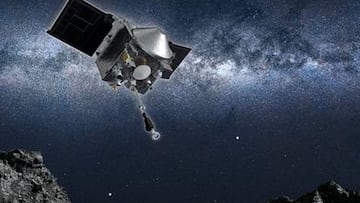When was the OSIRIS-REx probe launched to the asteroid Bennu and what materials has it collected?
The OSIRIS-REx mission is one of the most important NASA has carried out in recent years. It will be 100% completed Sunday when its payload lands in Utah.

NASA dedicates a good part of its resources to the study of the Solar System, its creation and the bodies that constitute it. The OSIRIS-REx mission is one of its most important projects to date, launced seven years ago to the study of the asteroid Bennu which it is hoped can provide more clues and hard data to resolving the mysteries that remain.
As confirmed by NASA on Friday, the mission will come to an end on Sunday 24 September, when it drops a capsule containing samples of rocky material from the Bennu. Scientists will be waiting for the payload in the desert of Utah where it will parachute down after blazing through the atmoshpere.
When was the OSIRIS-REx probe launched?
The OSIRIS-REx mission began on September 8, 2016, more than 7 years ago, with the launch of the special probe towards the asteroid Bennu, which was discovered in 1999. After travelling for two years it arrived at said asteroid in December 2018. It then analyzed the space rock, whose diameter is a little wider than the Empire State buildig is tall, until October 2020, when he landed on it and proceeded collected the samples. In January 2021 the probe undertook its 1.2 billion-mile return trip to bring back NASA’s first ever samples from an asteroid, Japan has done so twice before.
Tomorrow, NASA’s first sample of an asteroid will arrive on Earth!
— NASA Sun & Space (@NASASun) September 23, 2023
NASA’s OSIRIS-REx is flying by Earth to drop off a bit of 4.5-billion-year-old asteroid Bennu.
Live broadcast starts at 10am EDT tomorrow – don’t miss it! https://t.co/U8T7pZaI5r#ToBennuAndBack#OSIRISREx pic.twitter.com/I3MPWC0v8e
What materials has the OSIRIS-REx probe collected?
The OSIRIS-REx spacecraft will bring to Earth approximately 250 grams of rock and soil material collected from the surface of the asteroid Bennu, much more than were brought back from asteroid Ryugu in 2020 and asteroid Itokawa in 2010. The material will first be taken to a clean room for an initial examination at the US military’s vast Utah Test and Training range, its target touchdown site.
Related stories
After that it will be transported to the Johnson Space Center in Houston to be divided up into smaller specimens to be hand out to 200 scientists at 60 labs around the world for in depth study. It is hoped that organic materials or molecular precursors of life can be found.
The space probe is transporting the material in a capsule that it will release when it is about 63,000 miles from our planet. This gumdrop-shaped capsule will be what we will receive, since the ship will head back out into the solar system after releasing the cargo towards the asteroid Apophis to begin a new mission called OSIRIS-APEX.

